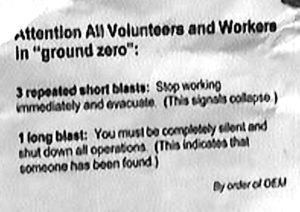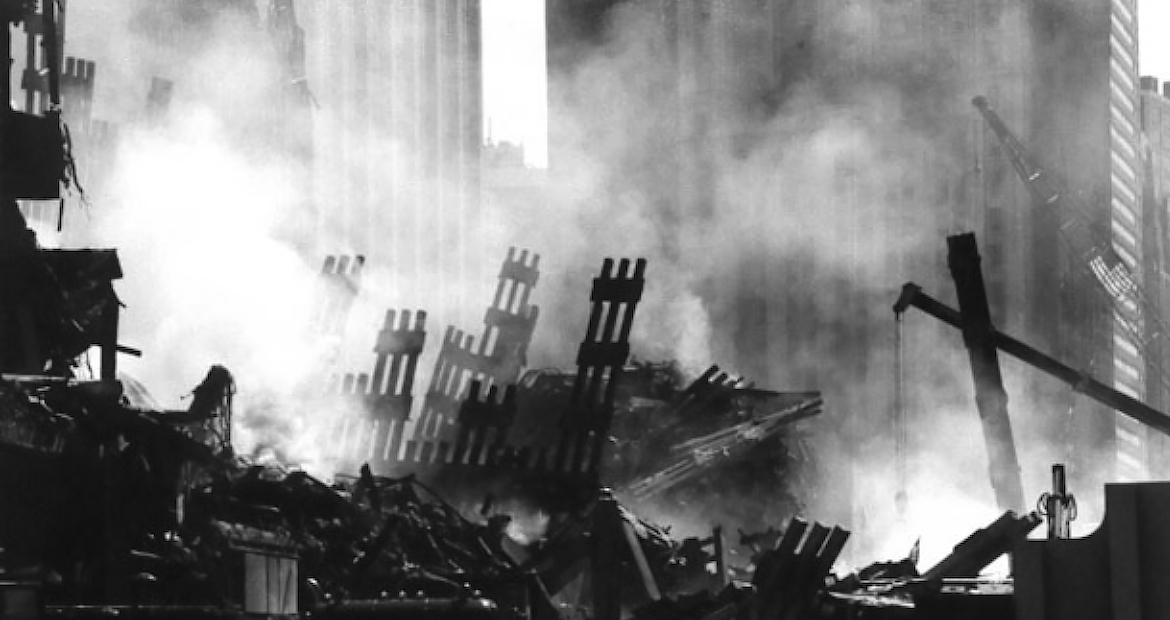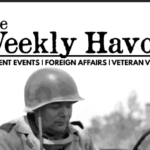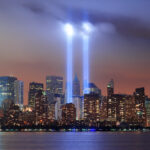
“I don’t want to go there.”
We’ve all said those exact words. A painful memory we don’t want to dredge up. A journey we’re dreading. A place or activity that we sense as being dangerous. Or scary. Or just a little bit creepy.
In the case of remembering the events of September 11, 2001 and the days following, many of us simply don’t want to go there. We’ve been there before—and we don’t want to go back. The images of the horror, the carnage, the twisted wasteland of Ground Zero remain seared in our memories.
But we need to look at this devastating tragedy again. We need to remember. We need to go back—but not alone. We need to see the aftermath of 9-11 with the help of a trusted guide. And our guide is Chaplain Bob Ossler.
I (Tim Shoemaker) first met Bob back in the early 70’s, so I’ve known him many years. Of all the people I’ve met in my life, Bob is not like any other person I know. He’s the king of going places and doing things that others dread, fear, or totally avoid. His career history backs that up.
A Chicago paramedic . . . in the darkest, most volatile projects of the inner city, Bob served in areas so dangerous that he often wore a bulletproof vest when going out on rescue calls. More than once he was attacked by drug-crazed people living in the projects.
A Chicago firefighter . . . rushing into buildings as others ran out.
A rescue diver . . . searching for victims in the ice cold, black waters of Lake Michigan while others stood on shore shivering.
A chaplain and pastor . . . helping people wrestle free from the forces of darkness.
I could go on and talk of other things Bob has done to help others, and tell you stories that would haunt you. He is one of the few men that I would trust with my life. If I were going into a scary or dangerous situation, I’d feel a whole lot better with Bob leading the way.
Which is why Bob, in his book Triumph Over Terror, will lead you safely back to the days immediately following 9-11. While so many of us watched the events in absolute shock and horror and fear, Bob raced to New York City to help. To do what he could do. And he didn’t just stay a day or two or three. Bob volunteered for five tours totaling forty-five days in that aftermath.
Ground Zero Chaplain Bob Ossler Remembers 9/11

Jumbled concrete chunks disarranged like the ruins of an ancient civilization; the fog of smoke and ash drifted over the trucks and volunteers; offensive odors assaulted my lungs. . . .
I needed to keep my emotions in check to be effective in my work. And so I kept repeating the words in my mind: This is just a movie set.
Our guide turned and looked over the small group of chaplains following his lead. “Welcome to the Gates of Hell.”
The gates of what?
That statement jarred me to my inner core, scaring me witless. Our guide’s description was definitely not scripturally sound. Hell cannot be portrayed in Hollywood terms or set designs. But as I walked and viewed the destruction and mayhem fueled by ten violent, suicidal Islamic extremist terrorists, I grasped from a feeble human’s point of view what hell might look, smell, and even taste like. An overbearing stench—the incense of hell—wafted from the Pile.

How did so much devastation happen in only 102 minutes? Our world will never be the same again. In 102 minutes the terrorist’s fait accompli destroyed the 16-acre World Trade Center complex.
This is real.
Arriving onsite at Ground Zero seven days after 9/11 proved to be gut-twisting, stomach-churning, and heart-wrenching. The televised images, however wretched, came nowhere near those firsthand smells, tastes, and sensations. Acrid smoke and toxic steam rose from fires raging underground. Putrefying bodies, few intact, remained trapped beneath the rubble. Choking, swirling dust and pulverized concrete mixed with DNA coated our tongues with grit. Hot metal seared through our thick-soled, leather work boots. Everything we touched—debris, trash, and yes, human bones, body parts, and pieces of flesh—fused themselves into memories that refused to leave.
But I was not even a first responder. I was not there in the minutes after the towers crashed to the ground. The first responders saw it all and bore the brunt of the
fear and trauma. Their stories, vivid in detail, sickened my stomach: men and women plummeting ninety stories to escape the burning jet fuel, heat and choking smoke, disintegrating on impact into flesh and exposed bone as they struck concrete sidewalks or the roof of the adjacent 22-story Marriott Hotel. I prayed for the brave individuals who witnessed the desperate jumpers. Hold them in Your arms, God, and comfort them. Shield their minds and hearts from the horror they’ve witnessed.
First responders, police officers, firefighters, and paramedics, rushed into the scene to save people and to extinguish the fires. But how could firefighters control flames started by nearly 24,000 gallons of jet fuel? How could they fight a conflagration of hellish proportions, eighty-plus stories up in the sky, beyond the reach of the tallest hook-and-ladder fire trucks and the longest fire hoses?
As I stood in horror, I thought of those terrorists who didn’t value the sacredness of life . . . who counted their success in dead bodies and mass murder. . . who believed violence to be acceptable to achieve their ends . . . who slaughtered several thousand people from all walks of life. The hideousness of senseless terrorism surpassed sane human thinking. This surreal, Spielberg-like scene really was a sliver of hell. In the midst of the shock, a whirlwind of questions reverberated through my heart: Will there be more attacks? How could this happen in our great country?
In the face of so much tragedy and suffering, many questioned, “Where was God? Why did God let this happen?”
As I stared at the piled remains of the WTC towers, I vowed to do my best to bring the love of Jesus here—and that vow, my friends, involved an enormous amount of prayer. Even now, years later, I shudder when I think about the Gates of Hell at Ground Zero.
Never Forget
“I don’t want to go there.” I know. Nobody does. But you won’t go alone. In Triumph Over Terror, Bob will walk you through the wasteland and bring you out on the other side. That’s the kind of thing Bob does. Sometimes it takes someone who’s been through the smoke and rubble to help us see our life problems—and solutions—more clearly. I think you’ll be glad you took the journey.
Triumph Over Terror chronicles daily events, people Bob met, and ultimately life lessons learned in those dark days following 9-11. But more than that, you’ll find hope. Healing. Perspective. Renewed strength and courage. And you’ll come away with critical life lessons to use as you show compassion and caring to those who suffer.
This is a short excerpt from Triumph Over Terror, published in 2016 by Blackside Publishing. Both the Book and ebook are available on Amazon.
______________________________________
Scoti Springfield Domeij is the proud Gold Star mom of 2/75 Army Ranger, Sgt. 1st Class Kristoffer Domeij, KIA on October 22, 2011 during his 14th deployment in Afghanistan. Kristoffer’s death inducted Scoti into the amazing military family and Ranger community. A civilian, Scoti is woefully ignorant of military protocol and acronyms.
She serves as Director of Springs Writers, is a solo-parenting columnist for Colorado Springs Kids, was editor/writer for nine publishers. She’s published in diverse publications including The New York Times, Southwest Art, School Daze, SAM Journal, and parenting magazines. She contributed stories to Violence of Action: The Untold Stories of the 75th Ranger Regiment in the War on Terror (Blackside Concepts), Love is a Verb Devotional and Heaven Touching Earth (Bethany House), Christmas Miracles (St. Martin’s Press), Extraordinary Answers to Prayer: In Times of Change (Guideposts), and The Mommy Diaries: Finding Yourself in the Daily Adventure (Revell).
A researchaholic, Scoti was Senior Research Assistant/Art Production Coordinator for the 27-part film series shot on location in Israel entitled That the World May Know. She interacted with top scholars, archeologists and museums while researching geography, seasons, feasts, culture, dress, facial ethnicity, machinery, furniture, weapons, wars, architecture, archeological discoveries, Roman culture and government, ancient religious beliefs, flora and fauna to conceptualize historically, archeologically and biblically-accurate art compositions used for over 200 art renderings and maps.
This article first appeared in The Havok Journal on September 11, 2018.
Buy Me A Coffee
The Havok Journal seeks to serve as a voice of the Veteran and First Responder communities through a focus on current affairs and articles of interest to the public in general, and the veteran community in particular. We strive to offer timely, current, and informative content, with the occasional piece focused on entertainment. We are continually expanding and striving to improve the readers’ experience.
© 2024 The Havok Journal
The Havok Journal welcomes re-posting of our original content as long as it is done in compliance with our Terms of Use.





